Simulating Flash Floods Using Geostationary Satellite-Based Rainfall Estimation Coupled with a Land Surface Model
Abstract
1. Introduction
2. Materials and Methods
2.1. Brief Description of the MATSIRO
2.2. Study Area
2.3. Data Preparation and Processing
3. Results and Discussion
4. Conclusions
Author Contributions
Funding
Conflicts of Interest
References
- Yousef, A.M.; Pradhan, B.; Hassan, A.M. Flash flood risk estimation along the St. Katherine road, southern Sinai, Egypt using GIS based morphometry and satellite imagery. Environ. Earth Sci. 2011, 62, 611–623. [Google Scholar] [CrossRef]
- Alfieri, L.; Thielen, J.; Pappenbeger, F. Ensemble hydro-meteorological simulation for flash flood early detection in Southern Switzerland. J. Hydrol. 2012, 424, 143–153. [Google Scholar] [CrossRef]
- Saharia, M.; Kirstetter, P.E.; Vergara, H.; Gourley, J.J.; Hong, Y.; Giroud, M. Mapping Flash Flood Severity in the United States. J. Hydrometerol. 2017, 18, 397–411. [Google Scholar] [CrossRef]
- Kim, E.S.; Choi, H.I. Estimation of the relative severity of floods in small ungauged catchments for preliminary observation on Flash flood preparedness: A case study in Korea. Int. J. Environ. Res. Public Health 2012, 9, 1507–1522. [Google Scholar] [CrossRef] [PubMed]
- Haile, A.T.; Rientjes, T.; Gieske, A.; Gebremichael, M. Multispectral remote sensing for rainfall detection and estimation at the source of the Blue Nile river. Int. J. Appl. Earth Obs. Geoinf. 2010, 12, S76–S82. [Google Scholar] [CrossRef]
- Kinoti, J.; Su, Z.; Woldai, T.; Maathuis, B. Estimation of spatial-temporal rainfall distribution using remote sensing techniques: A case study of Makanya catchment, Tanzania. Int. J. Appl. Earth Obs. Geoinf. 2010, 12, S90–S99. [Google Scholar]
- Suseno, D.P.Y.; Yamada, T.J. The role of GPS precipitable water vapor and atmospheric vertical stability index in the statistically-based rainfall estimation using MTSAT data. J. Hydrometerol. 2013, 14, 1922–1932. [Google Scholar] [CrossRef][Green Version]
- Wardah, T.; Abu Bakar, S.H.; Bardosy, A.; Maznorian, M. Use of geostationary meteorological satellite images in convective rain estimation for flash-flood forecasting. J. Hydrol. 2008, 356, 283–298. [Google Scholar] [CrossRef]
- Kuligowski, R.J.; Li, Y.; Hao, Y.; Zang, Y. Improvements to the GOES-R Rainfall Rate Algorithm. J. Hydrometerol. 2016, 17, 1693–1704. [Google Scholar] [CrossRef]
- Yang, J.; Zhang, Z.; Wei, C.; Lu, F.; Guo, Q. Introducing the New Generation of Chinese Geostationary Weather Satellites Fengyun-4. Bull. Amer. Meteor. Soc. 2017, 17, 1637–1658. [Google Scholar] [CrossRef]
- Song, H.J.; Lim, B.; Joo, S. Evaluation of Rainfall Forecasts with Heavy Rain Types in the High-Resolution Unified Model over South Korea, Wea. Forecasting. 2019, 34, 1277–1293. [Google Scholar] [CrossRef]
- Takata, K.; Emori, S.; Watanabe, T. Development of the minimal advance treatments of surface interaction and runoff. Glob. Planet. Chang. 2003, 38, 209–222. [Google Scholar] [CrossRef]
- Mishra, A.K. Effect of rain gauge density over the accuracy of rainfall: A case study over Bangalore, India. SpringerPlus 2013, 2, 311. [Google Scholar] [CrossRef] [PubMed]
- Oki, T.Y.; Sud, C. Design of Total Runoff Integrating Pathways (TRIP)-A global river channel network. Earth Interact. 1998, 2, 1–36. [Google Scholar] [CrossRef]
- Koirala, S.; Yamada, H.; Yeh, P.; Oki, T.; Hirabayashi, Y.; Kanae, S. Global Simulation Of Groundwater Recharge, Water Table Depth, And Low Flow Using A Land Surface Model With Groundwater Representation. Annu. J. Hydraul. Eng. 2012, 56. [Google Scholar] [CrossRef]
- Yamada, T.J.; Sasaki, J.; Matsuoka, N. Climatology of line-shaped rainbands over northern Japan in boreal summer between 1990 and 2010. Atmos. Sci. Lett. 2012, 13, 133–138. [Google Scholar] [CrossRef]
- Suseno, D.P.Y.; Yamada, T.J. Two-dimensional, threshold-based cloud type classification using MTSAT data. Remote Sens. Lett. 2012, 3, 737–746. [Google Scholar] [CrossRef]
- Vila, D.A.; Goncalves, L.G.; Toll, D.L.; Rozante, J.B. Statistical Evaluation of Combined Daily Gauge Observation and Rainfall Satellite Estimates over Continental South America. J. Hydrometeorol. 2009, 10, 533–543. [Google Scholar] [CrossRef]

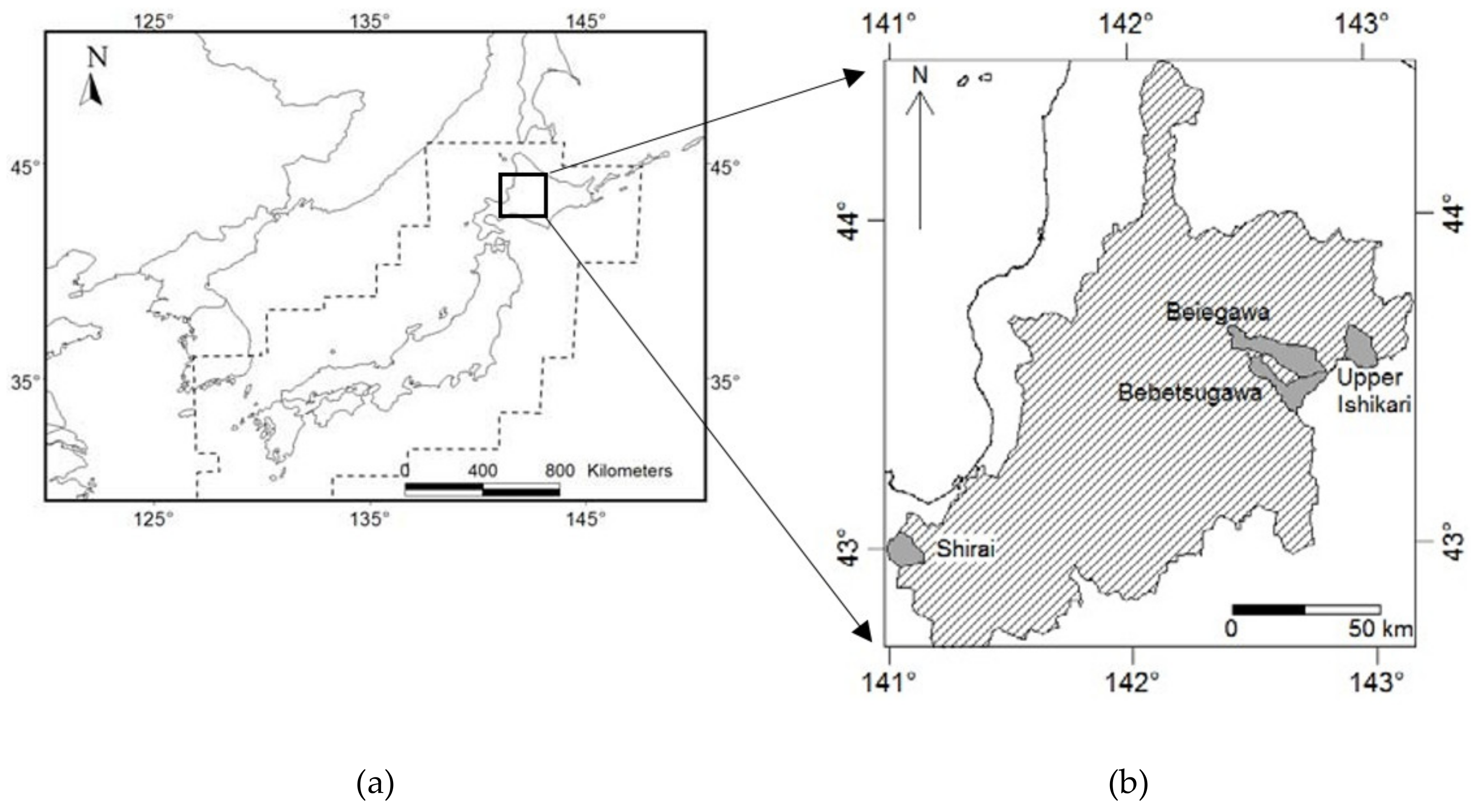
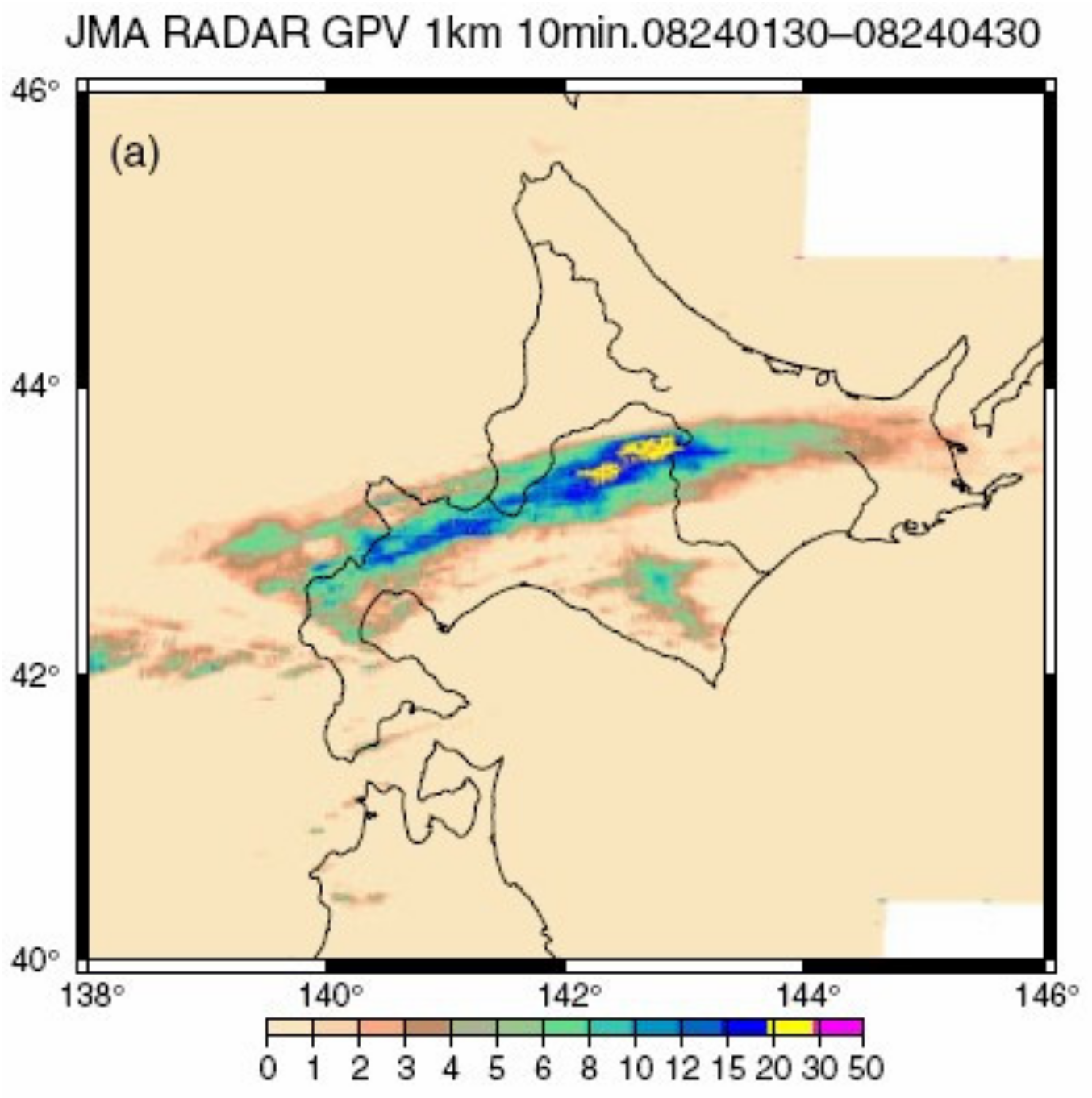
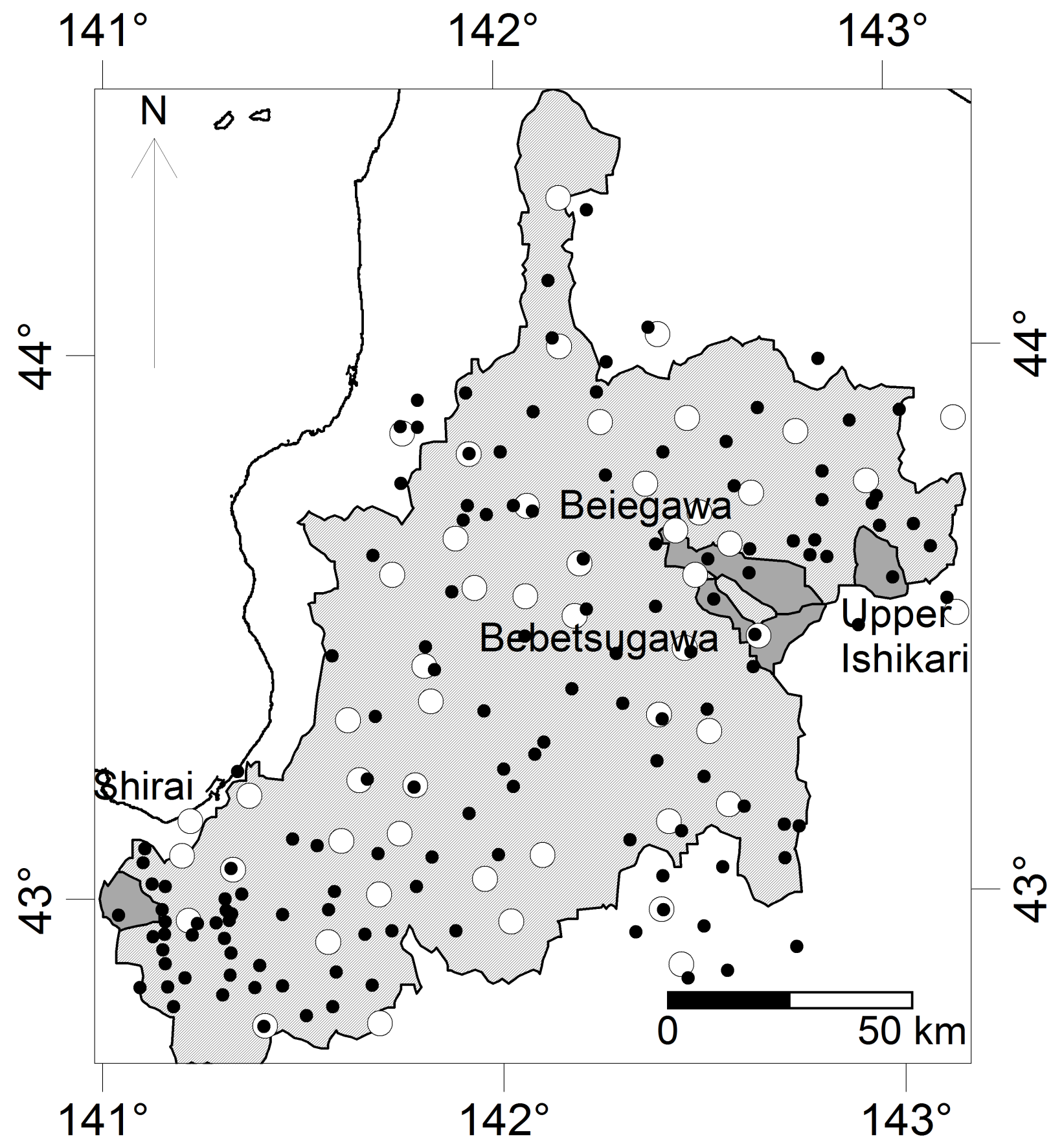
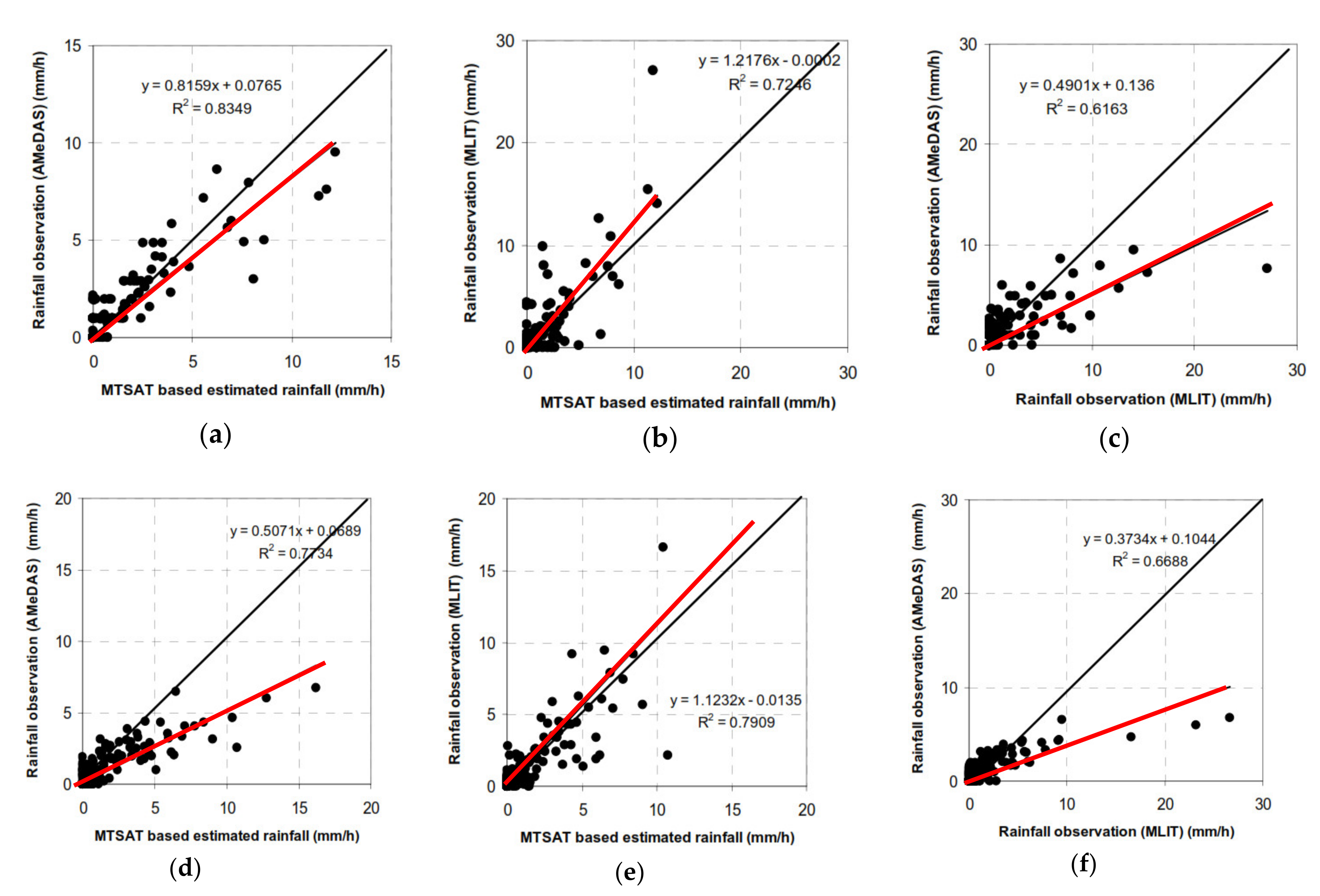
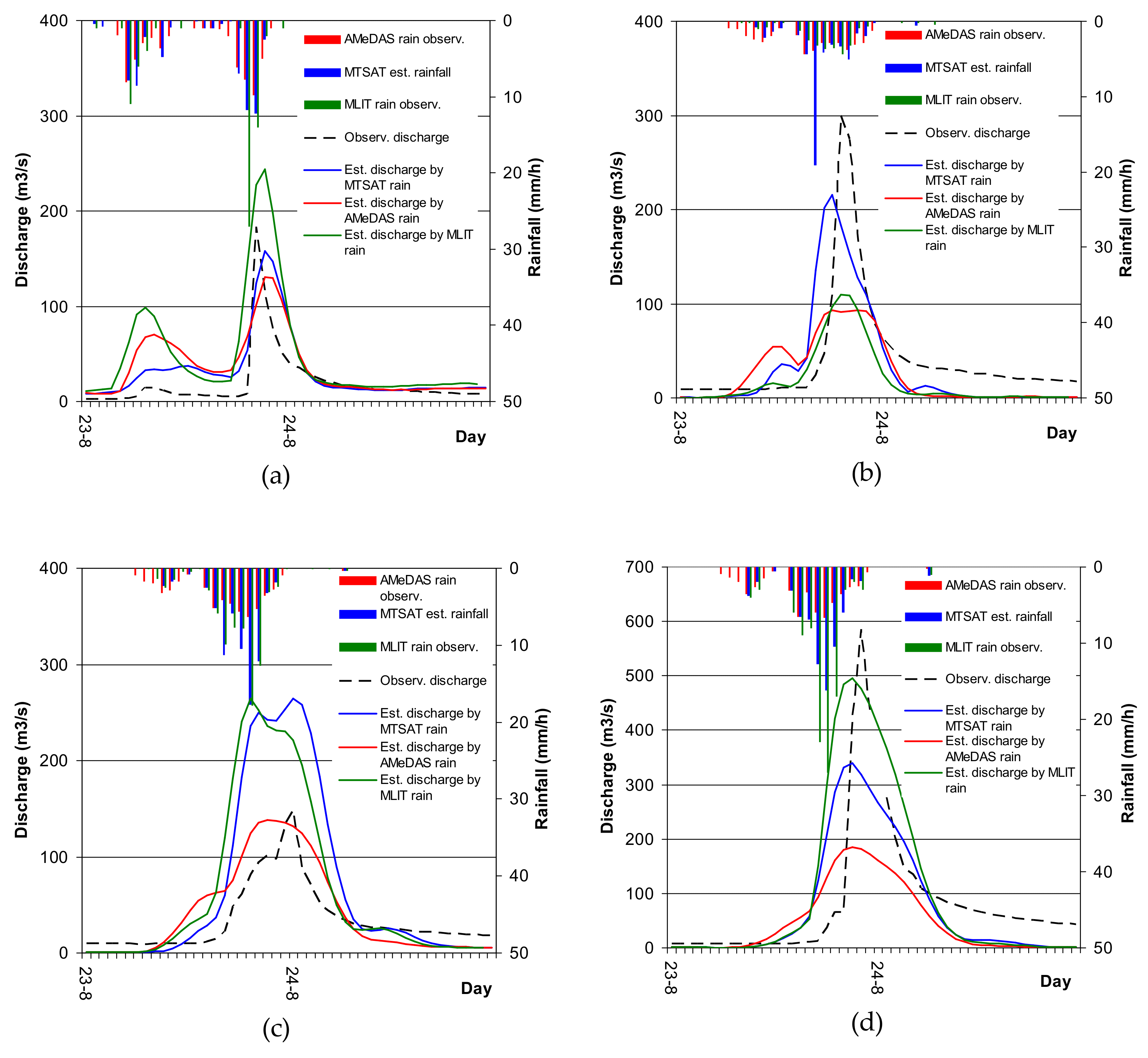
| Parameters | Source | Spatial Resolution | Temporal Resolution | Data Preprocessing |
|---|---|---|---|---|
| Atmospheric Parameters | ||||
| Precipitation (Rainfall) | AMeDAS observation | Point observation | 1 h | Spatial interpolation |
| MLIT observation | 1 h | Spatial interpolation | ||
| Remote sensing (MTSAT based estimation) | Point observation | 1 h | Spatial interpolation and statistical downscaling | |
| 5 km downscaled into 1-km | ||||
| Wind | AMeDAS observation | Point observation | 1 h | Spatial interpolation |
| Atmospheric Temperature | AMeDAS observation | Point observation | 1 h | Spatial interpolation |
| Atmospheric Pressure | AMeDAS observation | Point observation | 1 h | Spatial interpolation |
| Atmospheric Relative Humidity | AMeDAS observation | Point observation | 1 h | Spatial interpolation |
| Cloud cover | JMA Mesoscale Model | 25 km | 3 h | Spatial Resampling |
| Shortwave downward radiation | Remote sensing (CERES) | 20 km | ~12 h | Spatial Resampling |
| Longwave downward radiation | Remote sensing (CERES) | 20 km | ~12 h | Spatial Resampling |
| Land surface parameters | ||||
| Land use | Remote Sensing (MODIS) | 1 km | yearly | Geo-referencing and spatial resampling |
| Surface slope | Remote Sensing (SRTM-DEM) | 90 m | - | Spatial aggregation and DEM processing |
| Standard deviation of surface topography | Remote Sensing (SRTM-DEM) | 90 m | - | Spatial aggregation and DEM processing |
| Flow direction | Remote Sensing (SRTM-DEM) | 90 m | - | Spatial aggregation and DEM processing |
| Flow accumulation | Remote Sensing (SRTM-DEM) | 90 m | - | Spatial aggregation and DEM processing |
| Surface Albedo | Remote Sensing (MODIS) | 1 km | 16 days | Geo-referencing |
| Leaf Area Index | Remote Sensing (MODIS) | 1 km | 8 days | Geo-referencing |
| Soil texture | FAO digital soil map of the world | Vector based at 1:5,000,000 scale | - | Geo-referencing and spatial resampling |
| Simulation Name | Time Duration | Rainfall Data Forcing |
|---|---|---|
| Simulation I | 1 January–31 December 2010 | AMeDAS rainfall observation |
| Simulation II | 1 June–30 September 2010 | MLIT rainfall observation |
| Simulation III | 1 June–30 September 2010 | MTSAT downscaled |
| Catchment’s Name | Simulation I | Simulation II | Simulation III | ||||||
|---|---|---|---|---|---|---|---|---|---|
| Cor | Bias (m3/s) | RMS (m3/s) | Cor | Bias (m3/s) | RMS (m3/s) | Cor | Bias (m3/s) | RMS (m3/s) | |
| Shirai | 0.68 | 8.7 | 20.8 | 0.74 | 9.8 | 22.8 | 0.75 | 6.5 | 15.5 |
| Upper Ishikari | 0.61 | −2.7 | 16.9 | 0.71 | −4.9 | 14.1 | 0.67 | −0.7 | 19.0 |
| Beiegawa | 0.69 | 5.3 | 20.9 | 0.75 | 11.7 | 37.9 | 0.76 | 11.1 | 36.7 |
| Bebetsugawa | 0.51 | 2.1 | 32.1 | 0.70 | 8.4 | 41.3 | 0.60 | 7.1 | 36.9 |
© 2020 by the authors. Licensee MDPI, Basel, Switzerland. This article is an open access article distributed under the terms and conditions of the Creative Commons Attribution (CC BY) license (http://creativecommons.org/licenses/by/4.0/).
Share and Cite
Suseno, D.P.Y.; Yamada, T.J. Simulating Flash Floods Using Geostationary Satellite-Based Rainfall Estimation Coupled with a Land Surface Model. Hydrology 2020, 7, 9. https://doi.org/10.3390/hydrology7010009
Suseno DPY, Yamada TJ. Simulating Flash Floods Using Geostationary Satellite-Based Rainfall Estimation Coupled with a Land Surface Model. Hydrology. 2020; 7(1):9. https://doi.org/10.3390/hydrology7010009
Chicago/Turabian StyleSuseno, Dwi Prabowo Yuga, and Tomohito J. Yamada. 2020. "Simulating Flash Floods Using Geostationary Satellite-Based Rainfall Estimation Coupled with a Land Surface Model" Hydrology 7, no. 1: 9. https://doi.org/10.3390/hydrology7010009
APA StyleSuseno, D. P. Y., & Yamada, T. J. (2020). Simulating Flash Floods Using Geostationary Satellite-Based Rainfall Estimation Coupled with a Land Surface Model. Hydrology, 7(1), 9. https://doi.org/10.3390/hydrology7010009




